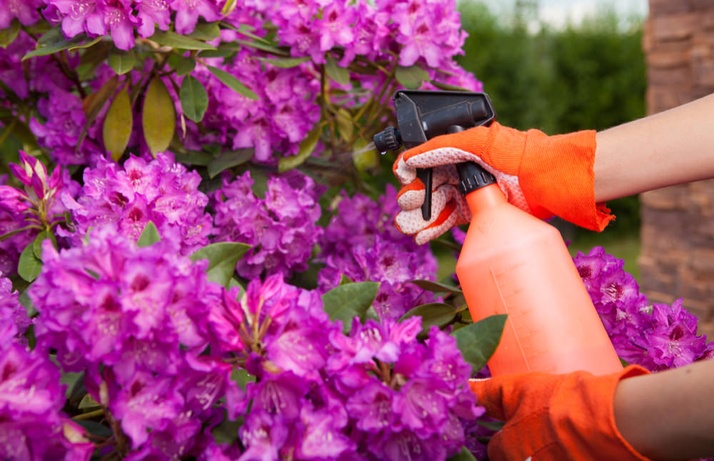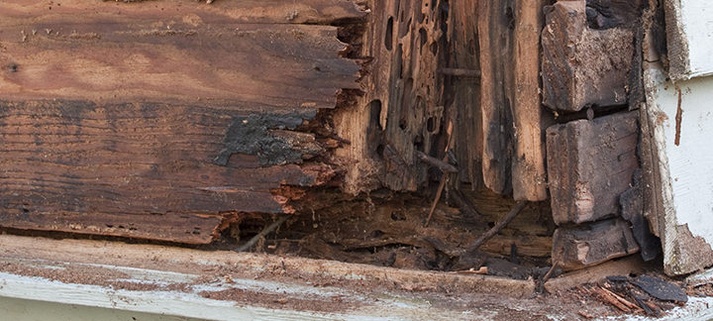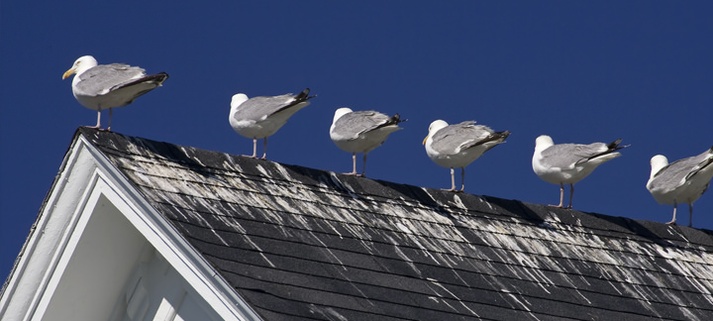Simple Ways to Keep Unwanted Squirrels and Raccoons Out

Squirrels, raccoons, and other pests are shrewd animals. If given the opportunity, they can sneak their way into your home and create extensive damage to your home. These animals can easily get into your home because they are small, agile, and extremely clever when motivated. To avoid major headaches, try these simple tips to keep unwanted animals out of your home.
- Trim back any tree branches that touch your home or property.
- Make sure your chimney has a properly installed cap and or screening, check to make sure it isn’t loose.
- Keep your gutters clean and installing gutter guards can also be very helpful.
- Make sure your garbage cans have lids on to cut off potential food sources. Also keep containers of bird, dog, and/or cat food closed tightly.
- Inspect your attic. Check to see if daylight shines through which indicates possible entry points. Vents at the peeks are often easy access points so installing screens behind these vents is helpful.
- Make sure all flashing on peeks is secure, animals can often force their way into these small entry points.
If you hear animals above in the attic or even in between the walls, you may already have an infestation. Rather than spraying repellents, which rarely work and cloud your home with toxic fumes or trying to trap the pest yourself, save time, energy, and money by calling a professional. Our certified experts can remove the unwanted pests in minimal time, remediate any entry points, and ensure your home is safe for your family.
3 Keys to a Successful Bed Bug Plan for Multi-Tennant Property Owners

Educate Your Residents
There are preventable measures that can be taken by your residents and staff, as well as important first steps to limit the exposure. Simply put, anyone can come across bed bugs. A reputable company like Anchor Pest Control will provide literature for your residents, training programs for your staff, and around the clock support for your property. Anchor offers a FREE Pest Identification Service to quickly identify and diagnose issues without a service call – saving you money!
Be Proactive, Not Reactive
If you are only doing a reactive approach you are costing your property more money. A penny of prevention is worth a hundred dollars of cure! Preventive inspection and monitoring devices can help you catch a problem at its earliest stages. This will decrease the damage and risk involved with a bed bug infestation. Currently, K-9 bed bug detection is the most effective tool available to find bed bugs prematurely, before they spread throughout an entire building. This can be done in a very cost-effective way by a licensed company with certified and trained K-9 dogs, such as Anchor Pest Control.
Proper Preparation
The #1 reason bed bug treatments fail is due to improperly prepared units for treatments. There is absolutely no reason to rush a bed bug treatment. It is critical that a resident properly prepares their property. If you are worried about bed bugs spreading and have the surrounding units treated preventively, no preparation is needed. If a resident is not able to prepare their unit themselves, it is important that you contact a licensed company, such as Anchor Pest Control, that can provide an affordable bed bug treatment preparation service.
Are you unhappy with your current Pest Control Company, looking for an affordable Maintenance Plan, have a question? Give Anchor Pest Control a call at (732) 636-8761 or visit us online today!
Looking to do some DIY Pest Control? Check out these tips.

There is a lot you can do to keep your home and yard from being a hangout for unwanted squatters. You can search the internet for a collection of tips and tricks, or check out a quick list that we put together right here!
Here is a list of things you can do:
- Caulk your house - Go around the inside and outside of the house with a caulk gun. Fill in every hole and crevasse. Even the tiniest holes can allow in critters and insects.
- Move the wood pile away from your house - Termites prefer a wooden highway, so don’t stack wood against the house. One infested log can be all they need to start eating your home.
- Wipe counters and floors - Using a simple solution of peppermint castile soap and water can be enough to keep ants and roaches out. They don’t like soap, so simply staying clean gives them nothing to eat.
- Spray vinegar and water - Spiders aren’t fans of vinegar. Spraying corners and cracks with vinegar and water can keep them out.
- Plant away from the house - Plants and bushes are a great way for everything from rodents to carpenter ants to get into the house. Leave a gap between the plants and the house.
- Beer is good - Put out saucers of beer to keep roaches away. They don’t like it, so they won’t go past or near it.
- Coffee is good, too - Ants won’t cross a coffee line. Simply leave a line of it in the back of cabinets or entry points and the ants will stop in their tracks. You can also use equal parts borax and sugar. Put it in small jars with holes in the lids. The ants will go in, but they won’t come out.
- Stop leaks - Leaky faucets give bugs a water supply. Turn off the water, and the insects are less likely to come around.
- Put a lid on it - Everything from your trash cans to your dry food containers should have lids. Cardboard boxes and plastic containers just give mice bedding and a meal.
- Cut branches - Branches that touch the house create an easy way for squirrels and other rodents to get onto and into the house.
- Close the roof - Make sure roof vents are intact. Bats will find the smallest holes and move right in.
- Bat houses - In your attic, bats are bad, but on your lawn, bats can keep the mosquito population down. Put up bat houses outside and the bats will eat the bugs in the air.
- Put a cap on it - Make sure your chimney and vents have caps. Opossums, raccoons, rats, and mice love the shelter when they can get in.
Rather than having to use chemicals or violence to eliminate pests, there are lots of simple, non-toxic ways to make your home a less hospitable place for pests to show up. Each of the above ideas will only take you a small amount of time, but they could save you large dollars exterminator fees!
Don’t let the bugs bite… But when you’re bit, this is what you should do.

It’s is part of being human, but it’s so annoying: getting bit by insects. Of course, the most common is a mosquito bite, but there are thousands of little bugs in the world that want a piece of you or want some peace from you. Here are some of the most common bug bites identified by what the bites probably look like.
Pinkish welt with a lot of itching
Mosquitoes: Most of us are very familiar with mosquito bites. They are often found on legs and arms, but can be anywhere. Hard bumps, often with a red dot in the middle, are the usual appearance of these bites. Sometimes they look like blisters. For the most part, mosquito bites are harmless in the US but in other parts of the world, they are responsible for the spread of malaria, zika, West Nile and more. Insect repellent, full covering clothes, and removal of nearby standing water will usually decrease the problem.
Reddish bumps with bleeding
You will know when a horsefly bites you. It can feel being stabbed. It’s very painful, sore and itchy. They are very aggressive and will stay around until they have had some of you. Their bites are open sores so it’s a good idea to put antibacterial treatments onto any bites to prevent infection.
Redness, swelling, sometimes blisters
Ant bites are usually not too painful, but for someone who’s allergic or from fire ants, the bites can be dangerous. Someone who is allergic to wasp or bee stings might especially susceptible to an allergic response. If you feel nausea, dizziness, sneezing, wheezing, or any other severe allergic symptoms seek medical attention immediately.
Blood drops on your sheets or small red welts
If you have been traveling, it might be bed bugs. This is especially true if there are small blood stains on your sheets in the morning. It might take a while to notice. They are notoriously difficult to get rid of. Get some professional assistance exterminating your home.
Bites in pubic hair, armpits, scalp, or eyebrows
If you have itching “down there” with bluish-grey skin reactions, you might have lice. There will often be tiny white eggs in the hair as well. Itching can begin right away or might happen 2 weeks later. There are shampoos that will eliminate them.
Bulls-eye rash around a swollen red bite
Lyme disease is spread by ticks. There’s usually a bulls-eye ring around the bite mark. This should be seen by a doctor immediately. Lyme Disease can be very dangerous.
Two tiny puncture marks with redness and swelling
There are thousands of spiders, but two in particular are of concern in the US: the black widow and the brown recluse. If you are bit and then experience muscle cramps, swelling sweating, increased blood pressure, you might have been bitten by a poisonous spider. Get medical attention immediately. These bites can be fatal.
Large blister or welt on the skin
This is likely a blister beetle. A chemical that is in the beetle causes a painful skin reaction. This is no lasting skin damage, but don’t crush blister beetles on your skin. This can cause a larger skin reaction.
Pimple-like rash near joints or between fingers
These are scabies and they aren’t caused by a bite. The little mites burrow under the skin and eat human skin. They are easy to remove, but kind of gross. There’s no lasting damage as long as it’s handled early.
No matter what you saw or didn’t see bite you, if you feel nauseous, dizziness, have muscle pain, eyesight issues, or any type of difficulty breathing, visit the doctor immediately. Most of the time, bug bites are harmless, but there are a few that are severe enough to need medical attention.
What You Need to Know if You See a Raccoon During Daylight

There is a tradition that if you see a raccoon during daylight hours, it has rabies. This makes sense because everyone knows that raccoons are nocturnal creatures. Nonetheless, it is not necessarily true.
Although they are nocturnal creatures, raccoons do normally move around during the day, just not as much. If they wake up hungry, they will go out and forage. This is particularly true for nursing females who need more energy to sustain themselves and their young.
If you see a raccoon at any time, don't approach it. While they might look like pets, they are still wild animals. Call us at Anchor Pest Control and we will remove the raccoon and its family. We can check it for rabies at that time.
When a raccoon is foraging during the daytime, there is an increased chance that it has rabies. Here are the five symptoms to look for that are definite indicators of rabies:
1 - Difficulty walking - Rabies causes paralysis. If you see a raccoon, or any mammal, that is struggling to use its hind legs, is walking circles, or seems paralyzed, they likely have rabies.
2 - Looks disoriented - Healthy raccoons are creatures with a purpose. If a raccoon looks confused or lost, it might be ill. Rabies causes disorientation and scrambles the thought processes.
3 - Foaming at the mouth - This is the classic symptom of rabies that you will always hear about. The problem is that if you are close enough to see this, you are already too close.
4 - Strange noises - Normally raccoons will chatter to each other. It sounds like they are talking. If your raccoon is making loud and bizarre noises, this is an indication that something is wrong.
5 - Looks ill - Just like any other animal, a raccoon will look ill. They will look lethargic, slow, feverish, or just plain sick looking. It's one of those things where you know it, even though it is hard to describe.
What to do
Call Anchor Pest Control if you are in New Jersey or surrounding states. If we aren't close enough, we will refer you to company that can help.
You can also call your local animal control officer. The reason that this is your second line of defense is that they are usually very busy and strapped for time. They are hard-working professionals who very often have too much territory to cover.
What will happen?
Whether it is Anchor that comes out or your local animal control officer, the animal will be captured alive using a humane trap. The animal can then be tested or checked for rabies.
If the animal is rabid, it needs to be euthanized. This is done as humanely as possible, with little pain. If it is not rabid, we will usually relocate it to a wild and open space where it will be far away from humans and can live out its raccoon life.
Click here to schedule a free estimate with Anchor Pest Control Services or give us a call at 732-636-8761 and our animal control experts will be happy to answer any questions you may have.
5 Pest Control Products Every Home Should Have on Hand
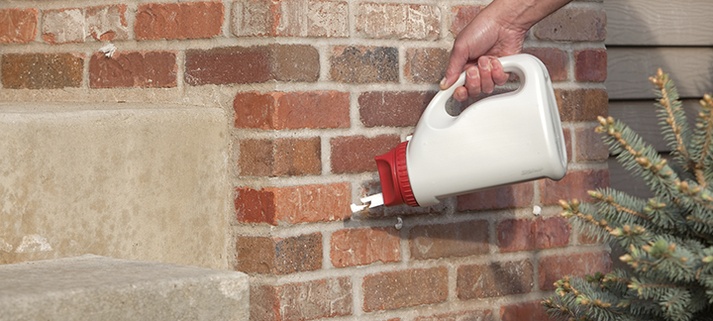
The worst part about household pests such as ants, roaches, and mice, is that they can show up at any time. There is no warning. Very often, their presence has nothing to do with anything that you can control. While your proximity to woods for example, may make it more likely for pests to invade your home, sometimes even location doesn’t matter. These pests are looking to get out of the harsh environment outdoors and into the comfort of your home. It can be very important to be prepared for this eventuality. There are some great over-the-counter products that can help to keep a minor infestation from turning into a major problem.
Ortho Home Defense Ready-to-Use Perimeter and Indoor Insect Killer (Link)
Available in almost any hardware store, this is a great all-around insect killer. Designed to be used indoors and near the home, it’s not toxic to animals and people, but will eliminate most insect problems quickly. It works for up to 12 months, so you won’t need to worry about the ant colony coming back over and over again. Home Defense draws your line in the sand (and the cabinets, closets, and basement). The bugs won’t cross the line. There’s no odor and it doesn’t stain fabrics or woodwork.
MotherEarth Granular Scatter Bait (Link)
A naturally-based solution to insects, this is a simple bait that uses borax to kill bugs. Borax is naturally occurring mineral that is non-toxic to humans, pets, or the environment. Because this is a broad-spectrum insecticide, it is a great product to keep around. It kills ants, cockroaches, crickets, earwigs, silverfish, slugs and snails. Borax gives MotherEarth Granular Scatter Bait a boric acid base. Boric acid has been used for centuries to kill and deter insects. You can blow this bait into cracks or use a spreader on lawns and gardens. It’s also great for paved areas, like patios, foundations, driveways, sidewalks, etc.
Spectracide Triazicide Insect Killer (Link)
If you need to spread insect killer on your lawn, this is the perfect product. You attach the bottle to your garden hose and simply water the lawn. It provides up to 3 months of protection. It kills over 260 types of insects, including ants, crickets, earwigs, and more. It’s perfect for lawns, garden, trees, and much more. A single bottle covers up to 5,120 square feet of lawn. That’s a significant area for just one application. Along with the ready-to-spray versions, it’s also available in granules and concentrates.
Vector 960 Fruit Fly Trap (Link)
Whether you have a restaurant or just a lot of fruits and veggies in your kitchen, fruit flies are a disgusting problem. Many people think it’s caused by an unclean space, but that’s not necessarily true. Fruit fly larvae live in the skins of fruits. They simply hatch because it’s warm and they’re ready. Sometimes, in restaurants and bars, there’s cleaning to be done, but at home, it just happens. The Vector 960 Fruit Fly Trap allows you track infestations. The food grade attractants draw the flies in and allow you to see what’s going on. It also makes it much easier to kill them. It’s a great way to know what in your kitchen is allowing the fruit flies to grow. If you own a commercial food operation, these traps will allow you to maintain your kitchen and understand what food storage is breeding fruit flies. Once you know where they are coming from, it’s much easier to eliminate them.
Cyonara Lawn, Yard, and Garden Spray (Link)
Cyonara is professional strength pest control for the home owner. Once attached to a garden house, one bottle can cover over 16,000 square feet of lawn. It kills over 100 lawn critters, like grubs, ants, fleas, mites, ticks, and much more. The professional strength means that you can apply this treatment once and be virtually assured that there will be no pests or disease-carrying insects for months.
Be Prepared
It might seem like overkill to have these items in a cabinet in your home, but stopping an infestation early is the best way to stop it completely. If insects are allowed to infiltrate your home or lawn for an extended period, they can find places to hide that are more difficult to get them out of.
6 Ways to Keep Pesky Birds Off Your Roof

Almost everyone loves birds. Their beautiful songs and brilliant colors can be appreciated by many. Nonetheless, when birds use your roof and attic as a nesting spot, it can be a pain in the tail feathers. Furthermore, it can even be dangerous. Bird droppings in large quantity can be a source of disease and allergens.
Here are six humane and easy ways to keep birds off of your roof and stop them from nesting in your home:
- Bird netting – You can go to a home improvement or gardening store and purchase netting that will keep the birds off of your roof. This specially designed netting doesn’t trap the birds, but keeps them from getting into places they don’t belong. Be sure to only buy bird netting; other types of nets can trap the birds and hurt them.
- Plastic cats and owls – There are some very realistic looking owl and cat figurines that you can place on your roof. Plastic figurines can scare these birds away, like scarecrows in the field.
- Aluminum strips – Cut cans and pie tins into strips and hang them along the edge of your roof. Birds don’t like the glare off of the metal and it confuses them. They are much less likely to nest because the flashing metal makes them nervous. This might not be the best solution if you are trying to sell your home, but it should work.
- Chili pepper spray – Crush chili peppers and put them in water outside for a few days if it’s warm. Once they have fermented, put the liquid into a spray bottle. If it’s cold out, you might need to keep it in the house. Spray the mixture around the edges of the roof and along the eaves. Bird dislike the smell and will relocate quickly. You might need to reapply it after it rains or snows. You should look into power-washer attachments for your garden hose that will allow you to spray the pungent liquid high without needing a ladder.
- Loud noises – Birds don’t like loud noises. You can bang pots, use explosions sounds through speakers, or any other loud sudden noises randomly throughout the day. After a while, the birds will fly away rather than deal with the noises. This ideas has its downsides; your neighbors might not love the sounds either.
- Humane trapping – There are many humane traps that you can purchase. These will capture the birds alive and unharmed. You will need someplace to release the birds. This can be the difficult part as you don’t want your bird problem to become someone else’s problem. Contacting your local animal control department might help you find a safe and respectful place to release the birds, like a local park or nature preserve.
All of these ideas can work, but as most DIY solutions, there is no guarantee that they will.
There is one guaranteed way to get rid of your unwanted birds: click here to request a free estimate. Anchor Pest Control. We will survey the situation and find the most effective ways to get rid of the birds quickly and efficiently. Anchor Pest Control can save you a lot of time and money from trial and error attempts with Bird Control in NJ.
Homeowner’s Guide to Handling Termites

Owning a home means that you are constantly vigilant against dangers to the structure and its occupants. One of the scariest discoveries a homeowner can make is a termite colony in or near the home. These little insects can literally eat you out of house and home.
This guide is designed to give you a little insight into dealing with termites, getting them out of your home and keeping them out.
Firstly, understand that termites love two things most in the world: moisture and wood. Anywhere that termites can find these two items, they will build a colony.
What to do when you find a termite colony
Fill in the cracks - The very first thing to do is to seal the house. Find cracks and holes and fill them. Termites can’t eat through caulk nor can they build a colony in fine sand. Using either of these materials to fill holes in the walls will help to keep termites out.
Dry up - Look for places where moisture is getting into your home. Broken gutters, poor window and door seals, and basement leaks can allow moisture into the home that termites will seek out. Get all of these items fixed as soon as possible so that you can get the moisture level in the home down. A dehumidifier can also help to reduce the overall humidity in your basement and the rest of the house.
Come back next year - Plan on checking every year for termites. Once you have dealt with an infestation, be sure to inspect your home at least once a year for termites.
Yucky wood - When you replace the wood in your home, use cedar, redwood, or juniper. Termites are not fans of these woods and so are less likely to gnaw on them.
What NOT to do when you discover a termite colony
Don’t touch - Once you’ve discovered a colony, the best thing is to leave the insects alone. If you disturb the colony without destroying them properly, they may get up and move. You may end up with infestations in multiple locations.
Don’t go it alone - The chemicals that are used to kill termites can be harsh. It’s best to get an expert to complete the extermination. This is even more important since an expert will also know to look in places that you might not have thought of.
Take away the food - Wood mulch and wood piles are termite havens. Don’t use wood mulch next to your home. If you have a wood pile, move it away from the house. Termites will start at the bottom of the pile, where the wood is moist and warm. Then they will work their way right into your home. If you have lumber stored on your property, use concrete blocks to keep it off the ground or suspend it overhead in a garage.
The Bottom Line With Termites
The key to keeping termites away is simple attention to detail; inspect your home at least once a year to make sure that you have no new residents. The key to dealing with a colony when you find it is to call an expert that can come to your home and destroy the colony quickly and effectively. Eradicating a termite problem quickly the first time can save you in time, energy and money. Get a quick quote online or call Anchor Pest Control at (732) 636-8761.
Bird Control: What’s the problem?
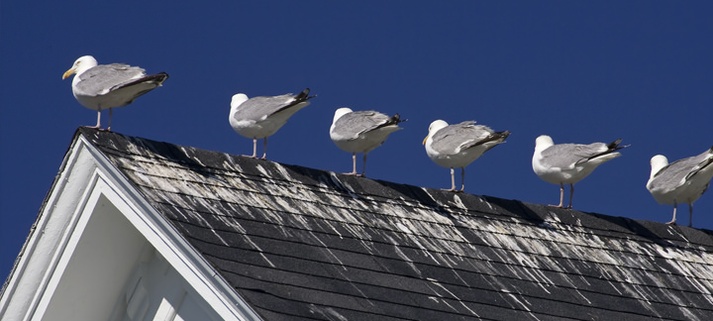
While birds are wonderful creatures, when they’re trespassing and wreaking havoc on your property, they can become a nightmare. Birds can make an unsanitary mess, are noisy, and generally make the outdoors, and even the inside of your house, an unpleasant place to be.
What’s the problem?
In most people’s minds, birds are those wonderful creatures that tweet and make the world a more pleasant place. For the most part, this is true, but in large numbers or the wrong location birds can be annoying and even dangerous.
● Unsanitary - Bird feces can carry lots of diseases. Because birds aren’t exactly house-trained, they tend to make a mess everywhere, including on the ground and above your head.
● Structural damage - To make room for nests and to find nesting materials, birds can take apart a house. Woodpeckers will use their beaks to drill holes into the walls looking for insects. Peacocks and other birds will tear out insulation looking for nesting materials and sometimes simply looking for something to eat.
● Tainted wood - Bird feces can soak into the wood of your home and make it essentially a diseased and nasty mess.
How do I know I have a problem?
If you find that there are birds in places they don't belong, like inside your house, under your eaves or flying around in your garage, you have a problem. If there is a place where you find piles of bird feces, you need to get rid of the birds. In the case of larger birds, like geese and ducks, they will chase you, your children and your pets off of your lawn.
In the attic and around the house, if you find a large number of feathers, you probably have a lot of birds, even if you don’t see them. Listen for scratching and pecking as well as the birds search for food and nesting materials.
What’s the resolution?
The first thing to do is to figure how the birds got to where they are and what’s keeping them there. For example, if you have a pond with a lot of grasses and brush growing up around it, there are many bird species that will hive in the grass. If you have a manicured lawn, Canada geese will land there to eat, especially if there’s water nearby. If there are pigeons in your attic, there must be holes in the roof, walls or eaves to let them in.
● Plug up any holes in the building or house
● Cut grasses near ponds and creeks
● Place dog shadow statues on the lawn to scare off Canada geese or get a dog that will do it
● Make sure you don’t have termites in your house’s wood that is attracting woodpeckers
● Put wire spikes in places where birds are likely to want to nest, such as eaves, signs, and gutters
● Clean your eaves and gutters regularly
● Make sure you have siding over all of the fiberglass insulation on your home and buildings
● Purchase some humane bird traps that can help to capture the birds; be sure to have a place to release them that is far enough away to keep them from coming back
In some places you can hunt the birds, but species like Canada geese are federally protected. If you aren’t able to get the birds to go away by attempting these simple ideas, call in a professional. They will have the tools to get the birds to leave and to not come back.
NJ Commercial Bed Bug Removal - Every Business Needs a Plan in Place (Your Pest Control Professional)

This is the third and final part of Every Business needs a Bed Bug Plan. In the first part, we talked about the importance of a risk management plan. The second part was dedicated to how to train employees to be the most important part of a bed bug defense plan. In this final installment, we will talk about the pest control professional.
Step 3: Your Pest Control Professional
Of course, the first thing to do is to choose the right provider. This is not really a place to refer to hire a brother-in-law just because that is what the family wants.
Choosing the right provider should start with researching reputations and references. If someone comes in to do a presentation, be sure to ask for references from current customers.
With your new provider, make sure that you understand what they will do, what they won’t do and what they expect to do for you.
You should ask what chemicals they will use, what trainings they will provide and how much they will need you and your staff to do.
Next is setting a budget. The key to this is to make sure that you balance the potential cost of a bed bug infestation and the ongoing costs of maintenance.
The final portion of your mission is to listen and follow instructions. Once you have hired a pest control professional, you need to think of them as the bug gurus. They are the experts. Do yourself a favor and don’t second guess the pros. Follow their instructions to the letter.
This final installment of the business guide to bed bugs is not comprehensive, but should allow any business owner to have a sense of control over their destiny where bed bugs are concerned.
The key to all of this is to remember that bed bugs can be a costly and painful experience. Have a plan and move forward with everything.



